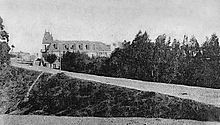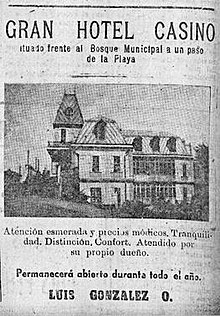Agustín Ross Cultural Centre
| Agustín Ross Cultural Centre | |
|---|---|
Centro Cultural Agustín Ross | |
Agustín Ross Edwards | |
Libertador General Bernardo O'Higgins |
Agustín Ross Cultural Centre (Spanish, Centro Cultural Agustín Ross), previously known as Casino Ross (Ross Casino), is the
It is best known for housing one of the first casinos of Chile; a casino operated in the building between 1917 and 1931. After 1931 all casinos, except the newly opened Casino de
Over time, the building deteriorated, and a project was approved in January 2007 for it to be renovated for use as a cultural center. The restored building opened in January 2009 and houses the local library. In January 2010, the cultural center was inaugurated by President Michelle Bachelet and Mayor Roberto Córdova.
History
1885–1906: The idea
For this purpose, Ross Edwards bought Fundo Pichilemu, a farm, from Juan Esteban Torrealba Maturana in 1885.
1906–1930: Construction; the casino

According to
The
1930–1995: The discotheques; the National Monument


After the casino closed, the building was mostly left unused until the 1940s, when the González Pérez family purchased it from Agustín Ross de Ferrari, a descendant of Ross Edwards. The family converted the building into a hotel, and in the late 1940s, the underground floor was remodeled and made a clandestine casino.
During the administration of Mayor
In 1987, after the re-inauguration of another work of Agustín Ross, the
1995–2008: Restoration
After the former casino was purchased by the government of Pichilemu, the building was used to hold meetings, exhibitions of paintings, sculptures, theater, and for launching books. In 1997, the Club Aéreo de Pichilemu (Aero Club of Pichilemu) requested the building to host the fiftieth annual reunion of the Air Federation of Chile. Permission was granted, but the Club Aéreo had to purchase toilet fixtures, as the ones in the building were seriously damaged.

On 14 February 2007, the Regional Secretary (Seremi) of the Ministry of Public Works, Beatriz Valenzuela, wrote in an article in the online newspaper El Rancahuaso, "The current state of the historic monument is bad, because of the deterioration of the roof, which over the years has had permanently leaked water and humidity. This can be easily seen in the damaged wood of its inside enclosure and the great frame of the mansard roof, which is of oak wood."[13] Some months later, on 23 August, Valenzuela announced that the restoration of the building would begin that same day, after it was authorized by the Regional Government; the building would become a cultural center, housing the local public library and art galleries.[18] The restoration work was the responsibility of development firm Atelier Consultores.[19]
During the restoration of the casino, a number of historical items were found. Those included newspapers, specifically a copy of Las Últimas Noticias from February 1941, during the time the building served as a hotel; a US telephone battery from 1909; and a tile from the casino's ceiling with signatures and drawings by casino workers in 1915.[20]
2009–present: Cultural center


The completely restored building opened on 23 January 2009, one hundred years after its original construction. An exhibition of photographs by Ana María Encina Lemarchand was the first to be staged in the restored building.
After the earthquakes of
Organization
The Centro Cultural Agustín Ross houses the local public library, and has four exhibition rooms, an auditorium, a music room, and several other rooms in which workshops take place for yoga, acrobatics, theatre, and other disciplines for people of all ages.[24] The restoration of the cultural centre prompted the creation of an independent organization called the Corporación Cultural de Pichilemu (Pichilemu Cultural Corporation).[23]
Public library
The Biblioteca Pública de Pichilemu (Public Library of Pichilemu) is the
The library was previously located in a dedicated building on Santa María Avenue from 1989 until 16 January 2009,[29] before relocating to the Centro Cultural Agustín Ross.[30] In September 2010, the library received a donation of 150 music and culture-related books with the help of Alejandra Domedel,[31] the cultural center's communications and cultural management officer.[32]
Pichilemu Cultural Corporation
Jorge Godoy Rojas, architect of the University of Chile, suggested in an January 2007 article he wrote for the online newspaper El Cachapoal that a semi-autonomous legal entity be set up for the management of the cultural center.
In May 2009, municipal employee Jorge Torres Avaca reported that the Cultural Corporation had been approved by the City Council, and its constitution was to be drawn up on 2 June;[22] it was approved on 11 June. Of the seven directors of the corporation, two are elected, two are appointed by the Pichilemu City Council, and another two by the regional or provincial government, and the mayor presides as the seventh member.[23] Longtime Pichilemu resident sculptor Macarena Irarrázabal Correa and Professor Carlos Leyton Labarca, native of the nearby village of Ciruelos and creator of the Museo del Niño Rural (Museum of the Rural Child), were elected.[23]
In popular culture

There is a popular myth surrounding the former casino which tells of caves between the Gruta de la Virgen (also known as the Gruta de Nuestra Señora de Lourdes; Grotto of Our Lady of Lourdes) and the building, crossing Agustín Ross Park. During the restoration of the building, in December 2007, it was reported that "two great walls constructed with flagstone, very wide and very close together" were found, but nothing was confirmed afterwards.[35]
Before the former casino building was completed, in 1908, Agustín Ross Edwards and Evaristo Merino reported to historiographer José Toribio Medina the existence of indigenous remains in the cave now called the Gruta de la Virgen. Medina asked Argentinean ethnographer Félix Faustino Outes to inspect the remains, and subsequently Medina wrote the book Los Restos Indígenas de Pichilemu (The Indigenous Remains of Pichilemu), using the report Faustino Outes gave him.[36]
American writer
See also
Notes
- ^ Quotation in the original Spanish: "se funde con los orígenes del Pichilemu moderno, restaurando sus instalaciones para hacer aquello que es tan necesario: dar cabida a la creatividad, al talento, a la imaginación, a los sueños de tantos jóvenes y de tantas personas"
References
- ^ Pichilemu News (in Spanish). Archived from the originalon 15 March 2012. Retrieved 24 July 2011.
- ^ a b c d e f "Casino (antiguo) de Pichilemu y los Jardínes del Parque Agustin Ross" (in Spanish). National Monuments Council. Archived from the original on 1 March 2012. Retrieved 6 December 2009.
- ^ Pichilemu News (in Spanish). Pichilemu, Chile. Archived from the originalon 24 August 2011. Retrieved 3 July 2011.
- ISBN 978-1-74104-779-0. Retrieved 24 July 2011.
- ^ Pichilemu News (in Spanish). Archivedfrom the original on 15 March 2012. Retrieved 24 July 2011.
- ^ Pichilemu News (in Spanish). Archivedfrom the original on 8 July 2011. Retrieved 23 July 2011.
- ISBN 978-1-74059-997-9.
- Pichilemu News (in Spanish). Archivedfrom the original on 15 March 2012. Retrieved 23 July 2011.
- ^ Chile.com. "Pichilemu" (in Spanish). Chile.com. Archived from the original on 26 March 2008. Retrieved 7 December 2009.
- ^ Antonio Saldías González (1990). Pichilemu: Mis fuentes de información (in Spanish). El Promoucae. Retrieved 12 January 2010.
- ^ Pichilemu News (in Spanish). Archivedfrom the original on 15 March 2012. Retrieved 20 January 2015.
- ^ "Agustín Ross Edwards" (in Spanish). Library of the National Congress of Chile. 30 December 2009. Archived from the original on 22 July 2012. Retrieved 23 July 2011.
- ^ a b c Valenzuela, Beatriz (14 February 2007). "Recuperando el Patrimonio Histórico en la costa de nuestra región: 100 años de historia". El Rancahuaso (in Spanish). Archived from the original on 27 February 2012. Retrieved 23 July 2011.
- Pichilemu News (in Spanish). Archivedfrom the original on 15 March 2012. Retrieved 24 July 2011.
- ^ "Votación Candidatos por Comuna Pichilemu Municipales 1992" (in Spanish). Ministry of the Interior of Chile. 1992. Archived from the original on 7 July 2011. Retrieved 23 July 2011.
- ^ Orellana, Paula (15 December 2006). "¿Restaurar el casino de Pichilemu?". El Rancahuaso. Archived from the original on 27 February 2012. Retrieved 24 July 2011.
- Pichilemu News (in Spanish). Archivedfrom the original on 15 March 2012. Retrieved 23 July 2011.
- ^ Valenzuela, Beatriz (23 August 2007). "Se inicia recuperación de edificio histórico: Casino Ross de Pichilemu". El Rancahuaso (in Spanish). Archived from the original on 28 March 2012. Retrieved 23 July 2011.
- Pichilemu News (in Spanish). Archivedfrom the original on 15 March 2012. Retrieved 23 July 2011.
- ^ Valenzuela, Beatriz (29 October 2007). "Hallazgos históricos en la obra de restauración del ex casino Ross de Pichilemu". El Rancahuaso (in Spanish). Archived from the original on 7 July 2011. Retrieved 23 July 2011.
- ^ Pichilemu News (in Spanish). Archivedfrom the original on 15 March 2012. Retrieved 24 July 2011.
- ^ Pichilemu News (in Spanish). Archivedfrom the original on 15 March 2012. Retrieved 23 July 2011.
- ^ Pichilemu News (in Spanish). Archivedfrom the original on 15 March 2012. Retrieved 23 July 2011.
- ^ a b c "Más de 84 mil millones invertirá el Gobierno; Presidenta Bachelet puso la primera piedra del nuevo hospital regional" (in Spanish). Intendance of Libertador General Bernardo O'Higgins Region. 28 January 2010. Archived from the original on 2012-03-28. Retrieved 23 July 2011.
- Pichilemu News (in Spanish). Archivedfrom the original on 8 July 2011. Retrieved 24 July 2011.
- ^ "Presidenta Bachelet causa conmoción en Pichilemu". El Rancahuaso (in Spanish). 27 January 2010. Archived from the original on 28 March 2012. Retrieved 24 July 2011.
- Pichilemu News (in Spanish). Archivedfrom the original on 15 March 2012. Retrieved 24 July 2011.
- ^ Jérez Reyes, Julio (25 February 2011). "Financiamiento para restauración de obras emblemáticas demorará entre tres y cinco años". El Tipógrafo (in Spanish). Archived from the original on 19 March 2012. Retrieved 24 July 2011.
- ^ a b "Biblioteca de Pichilemu 244 BC1". BiblioRedes. 2009. Archived from the original on 7 March 2012. Retrieved 12 August 2010.
- ^ Escárate, Daniela (22 January 2010). "Pichilemu: entre la aristocracia y el surf". La Nación (in Spanish). Archived from the original on 25 January 2010. Retrieved 24 July 2011.
- ^ Sepúlveda, Alejandra (26 September 2010). "Con nuevos textos cuenta Biblioteca de Pichilemu". El Rancagüino Online (in Spanish). Archived from the original on 27 September 2011. Retrieved 24 July 2011.
- ^ "Quienes Somos" (in Spanish). Centro Cultural Agustín Ross. 2011. Archived from the original on 6 October 2012. Retrieved 17 September 2011.
- Pichilemu News (in Spanish). Archivedfrom the original on 30 April 2012. Retrieved 24 July 2011.
- Pichilemu News (in Spanish). Archivedfrom the original on 15 March 2012. Retrieved 24 July 2011.
- ^ Valenzuela, Beatriz (9 December 2007). "Pichilemu: reconstrucción del ex casino Ross; ¿existen las cuevas subterráneas?" (in Spanish). Atina Chile. Archived from the original on 2012-03-21. Retrieved 23 July 2011.
- ^ Medina, José Toribio (1908). Los restos indígenas de Pichilemu (in Spanish). Imprenta Cervantes. Retrieved 20 July 2010.
- ISBN 978-956-264-113-5. Retrieved 24 July 2011.
- Pichilemu News (in Spanish). Archivedfrom the original on 1 March 2012. Retrieved 4 September 2010.
External links
 Media related to Centro Cultural Agustín Ross at Wikimedia Commons
Media related to Centro Cultural Agustín Ross at Wikimedia Commons- Centro Cultural Ross (in Spanish)
- Biblioteca de Pichilemu 244 BC1 (in Spanish)


